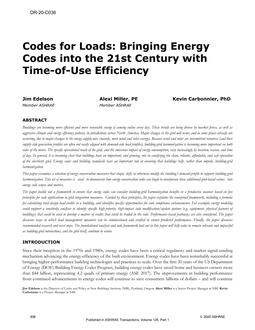
OR-20-C036 — Codes for Loads: Bringing Energy Codes into the 21st Century with Time-of-Use Efficiency
Buildings are becoming more efficient and more renewable energy is coming online every day. These trends are being driven by market forces, as well asaggressive climate and energy efficiency policies, in jurisdictions across North America. Major changes to the grid will occur, and in some places already areoccurring, due to major changes to the energy supply mix (mainly, more wind and solar energy). Because wind and solar are intermittent resources (and theirsupply-side generation profiles are often not easily aligned with demand-side load profiles), building-grid harmonization is becoming more important on bothsides of the meter. The specific operational needs of the grid, and the emissions impact of energy consumption, vary increasingly by location, season, and timeof day. In general, it is becoming clear that buildings have an important, and growing, role in catalyzing the clean, reliable, affordable, and safe operationof the electricity grid. Energy codes and building standards have an important role in ensuring that buildings help, rather than impede, building-gridharmonization.
This paper examines a selection of energy conservation measures that shape, shift, or otherwise modify the building’s demand profile to support building-gridharmonization. This set of measures is used to demonsrate how energy conservation codes can begin to incorporate these additional grid-based values intoenergy code scopes and metrics.
The paper builds out a framework to ensure that energy codes can consider building-grid harmonization benefits in a productive manner based on fiveprinciples for code applications to grid integration measures. Guided by these principles, the paper explains the conceptual framework, including a formulafor calculating total design load credits in a building, and identifies specific opportunities for code compliance enhancements. For example, energy modelingcould support a sensitivity analysis to identify specific high-priority, high-impact code modification/update options (e.g. equipment, physical features ofbuildings) that could be used to develop a matrix of credits that could be traded in the code. Performance-based pathways are also considered. The paperdiscusses ways in which load management measures can be commissioned and verified to ensure predicted performance. Finally, the paper discussesrecommended research and next steps. The foundational analysis and code framework laid out in this paper will help codes to remain relevant and impactfulas building-grid interactions, and the grid itself, continue to evolve.
Citation: 2020 Winter Conference, Orlando, FL Conference Papers
Product Details
- Published:
- 2020
- Number of Pages:
- 8
- Units of Measure:
- Dual
- File Size:
- 1 file , 1.6 MB
- Product Code(s):
- D-OR-20-C036


